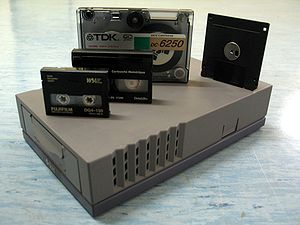Tape drive

A tape drive, also known as a streamer, is a data storage device that reads and writes data stored on a magnetic tape or a punched tape. It is typically used for archival storage of data stored on hard drives. Tape media generally has a favorable unit cost and long archival stability.
Instead of allowing random-access to data as hard disk drives do, tape drives only allow for sequential-access of data. A hard disk drive can move its read/write heads to any random part of the disk platters in a very short amount of time, but a tape drive must spend a considerable amount of time winding tape between reels to read any one particular piece of data. As a result, tape drives have very slow average seek times. Despite the slow seek time, tapes drives can stream data to tape very quickly. For example, modern LTO drives can reach continuous data transfer rates of up to 80 MB/sec, which is as fast as most 10,000 rpm hard disks.
Tape drives can be connected to a computer with SCSI (most common), Fibre Channel, parallel port, IDE, USB, FireWire or other interfaces. Tape drives can range in capacity from a few megabytes to upwards of 800 GB. Tape drive storage is usually referred to with the assumption of 2:1 compression; the raw storage capacity is known as the native capacity.
Tape drives can be found inside autoloaders and tape libraries which assist in loading, unloading and storing tapes.
In the 1980s some forms of tape drives were used as inexpensive alternatives to disk drives, examples include the ZX Microdrive and Rotronics Wafadrive.
References
This article is based on material taken from the Free On-line Dictionary of Computing prior to 1 November 2008 and incorporated under the "relicensing" terms of the GFDL, version 1.3 or later.
